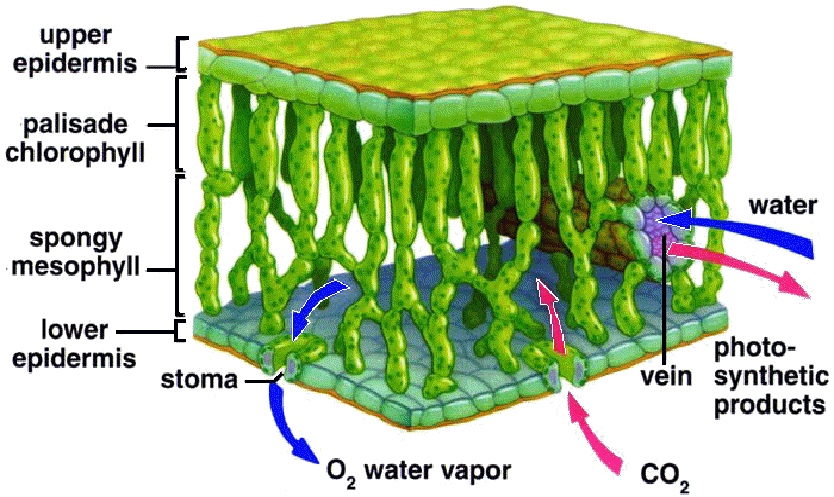| Leaf Morphology: Simple vs. Compound Venation Leaf Anatomy: |
| Leaf Morphology: Simple vs. Compound Venation Leaf Anatomy: |
Leaf Morphology: leaves are adapted as the main photosynthetic organ of the plant. Leaves are composed of the lamina or blade and the petiole. The lamina is flattened with distinctive upper and lower surfaces. The petiole is an elongated stalk that attaches the lamina to the stem at the node. Some leaves have outgrowths called stipules where the petiole attaches to the stem. In grasses the base of the leaf is expanded into the leaf sheath which attaches around the node.
Simple vs. Compound Leaves: A simple leaf has a single blade. A compound leaf has a blade divided into two or more subunits called leaflets or pinnae. Leaflets attached to a central point on the petiole are called palmate. If leaflets are attached along the length of the petiole they are called pinnate.
Venation: the vascular tissues in leaves forms a system of veins. In dicots the veins form a closed network called netted or reticulate venation. In monocots the larger veins are parallel to each other called parallel venation.



Dermal Tissue: the epidermis of a leaf is different on the adaxial (upper) and abaxial (lower) surface. The upper leaf surface has few or no stomata compared to the lower surface. Trichomes (hairs) may cover one or both surfaces. The epidermal cells are usually covered with a waxy cuticle which reduces water evaporation from the leaf, and also reduces gas exchange.
Ground Tissue: the mesophyll (the ground tissue in the middle of the leaf) is the site of photosynthesis. In most plants (especially dicots) the mesophyll is made up of two distinct layers. The palisade parenchyma lies just under the epidermis and consists of elongated, cylindrical parenchyma cells that are arrayed perpendicular to the leaf surface. This layer maximizes exposure of the chloroplasts to the sun. Just under the palisade parenchyma is the spongy parenchyma. The Spongy parenchyma consists of irregular cells clustered together to create large air spaces between cells. The air spaces aid in gas exchange between the leaf and the outside air. The air spaces in the mesophyll are continuous with air spaces adjacent to the stomata.
Top of Page
Vascular Tissue: the xylem and phloem in leaves are confined to vascular bundles or veins. Veins are surrounded by a layer of cells call the bundle sheath. The bundle sheath can be composed of parenchyma, colenchyma, or fibers. The parenchyma cells are typically modified as transfer cells that aid in movement of organic solutes from the mesophyll parenchyma cells to the phloem sieve tubes in the leaf. No cell in the mesophyll is more than two or three cells from a vascular bundle. The xylem in the vascular bundle is found on the upper (adaxial) side of the vascular bundle while the phloem is found on the lower (abaxial) side.
Top of Page
